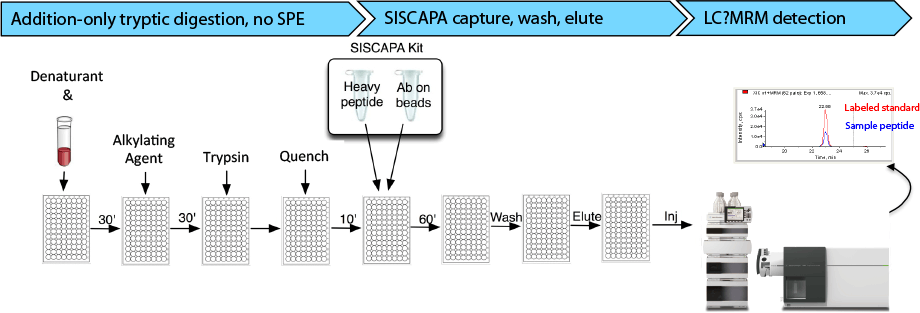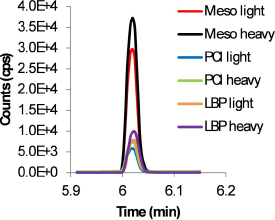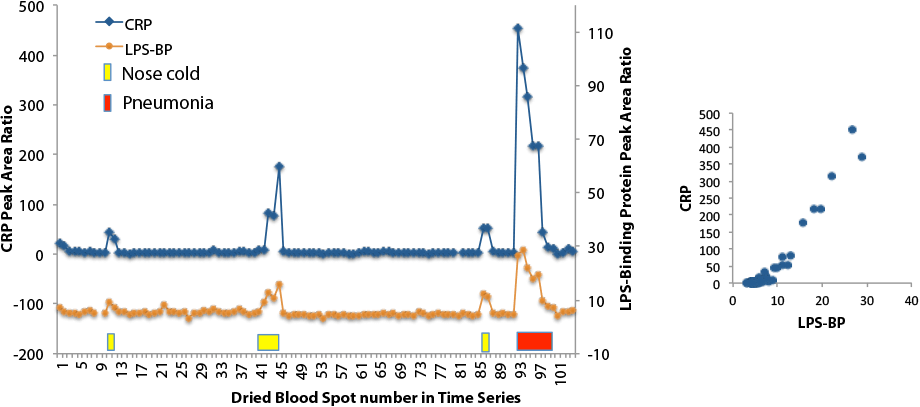Access Agilent eNewsletter, September 2014
>> Update My Profile | Subscribe to Access Agilent | Article Directory
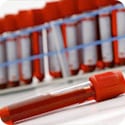
SISCAPA and Agilent deliver solutions for targeted protein quantitation
By Leigh Anderson
SISCAPA Assay Technologies, Inc.
and Sandy Yates
Agilent Automation Solutions
SISCAPA stands for Stable Isotope Standards and Capture by Anti-Peptide Antibodies. SISCAPA Assay Technologies developed the technology solution, with assistance from Agilent, to provide sensitive quantitation of protein biomarkers by using proteotypic peptides for the markers of interest.
How does SISCAPA work?
 Enlarge
Enlarge
Figure 1. SISCAPA workflow with Agilent Bravo robot and Agilent MS gives fast results in under 6 hours.
Biological samples (usually blood or plasma) containing the target protein are digested to peptides, spiked with a heavy isotope proteotypic peptide standard(s), purified by high-affinity immunocapture on magnetic beads, and analyzed by MRM (Multiple Reaction Monitoring) mass spectrometry. By comparing unlabeled peptide to standards, the specific protein concentration in the initial sample can be determined. Figure 1 shows an automated SISCAPA workflow, from blood tube to mass spec in 4 to 6 hours. The process involves addition-only tryptic digestion of plasma, followed by immunocapture using antibodies on magnetic beads. This is carried out in 96-well plates for samples up to 400 µL, and takes about 2 hours of robot time per plate on the Agilent Bravo Automated Liquid Handling Platform.
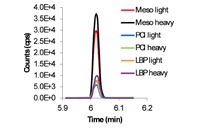 Enlarge
Enlarge
Figure 2. Direct injection of SISCAPA peptides for very high throughput using Agilent RapidFire 365 High-throughput MS.
 Enlarge
Enlarge
Figure 3. SISCAPA assays C-reactive protein and lipopolysaccharide binding protein acute phase markers in dried blood spots.
Better quantitation of protein biomarkers
The current gold standard for protein biomarker quantitation is classic sandwich immunoassay, where quantitation comes from fluorescence detection using secondary antibodies. These assays suffer from cross-reactivity, matrix interferences, and longer more expensive development cycles. SISCAPA enrichment combined with MRM mass spec provides high levels of sensitivity and specificity while avoiding the pitfalls of immunoassays. SISCAPA has the additional benefits of being able to multiplex without the risk of cross-reactivity, and having faster and less expensive assay development cycles with fewer confounding factors as compared to immunoassays. In addition, because SISCAPA results in highly purified peptide analytes free of matrix components, the assays can be higher throughput and amenable to plate-based automation in front of LC/MS or SPE/MS. SISCAPA-enriched peptides can be directly injected into the MS, without an LC, enabling very high throughput with the Agilent RapidFire 365 High-throughput MS System. RapidFire 365 direct peptide elution from a C18 trap (all peptides in one peak 〜2 seconds wide) gives a sample-to-sample cycle time around 7 seconds (Figure 2).
SISCAPA in action
Figure 3 shows the results of SISCAPA assays for CRP (peptide ESDTSYVSLK) and LPS-binding protein (peptide LAEGFPLPLLK) in 104 serial dried blood spots collected over 4.5 years from one individual. The response of CRP to infection was strong (370 standard deviations from stable healthy baseline at peak of pneumonia). The response of LPS-BP is less strong (55 standard deviations from the stable baseline). CRP and LPS-BP strongly correlate for acute phase inflammatory markers, as expected.
Targeted protein quantitation for protein chemists
SISCAPA technology will be of value to anyone currently doing or looking to do targeted protein quantitation. This includes analysts working on biomarker validation, or looking to migrate immunoassays to mass spec-based lab developed tests. Those of you working in biopharma on protein bioanalysis to measure the levels of a therapeutic protein, antibody, or antibody conjugate in DMPK, or protein pathway research can also benefit from this integrated solution.
Partnership provides biopharma solutions
Agilent collaborates with SISCAPA to bring this exciting solution to biopharmaceutical labs. Learn more about quantitative proteomics and discover how the SISCAPA workflow is suitable for routine multiplexing quantitation of plasma protein biomarkers with sensitivity, scalability, reproducibility, and throughput in Agilent Application Note 5991-4120EN. Next, explore free tutorial videos on the Agilent Bravo SISCAPA workflow and webinar overview on SISCAPA technology.
>> Update My Profile | Subscribe to Access Agilent | Article Directory
